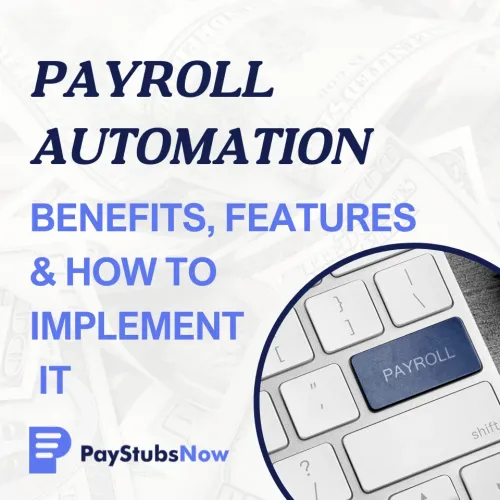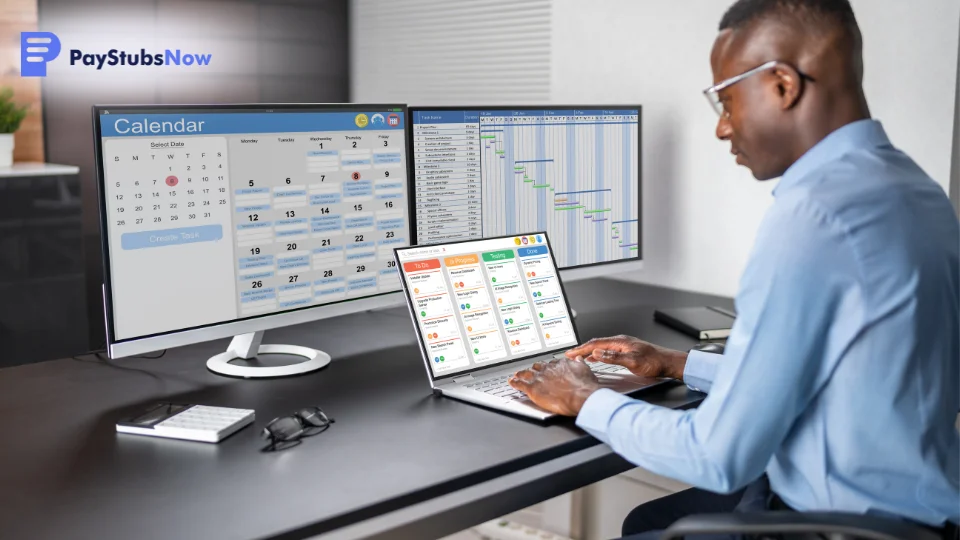


Running a business entails many responsibilities, and one of the most crucial is employee payroll. Since payroll management has become increasingly complex, payroll automation has emerged as a game-changer, allowing organizations to streamline their payroll operations, minimize errors, and ensure compliance with complex tax rules .
If your business is looking for ways to improve payroll operations, you need to understand the benefits, features, and implementation steps of payroll automation. This article explores these aspects, providing practical insights that can help you harness the power of automation in payroll management.

Payroll automation refers to the use of software and technology to execute and manage payroll processes with minimal manual intervention. Instead of relying on manual calculations and paper-based record-keeping, an automated payroll management system handles various tasks, including calculating wages, deductions, and taxes, generating paychecks, processing direct deposits, and generating payroll reports. By automating these repetitive payroll tasks, businesses, particularly small businesses , can reduce their administrative burden and invest time and resources in more strategic initiatives.
 Implementing payroll automation brings a host of benefits for businesses of all sizes. By transitioning from manual processes to an automated system, an organization effectively:
Implementing payroll automation brings a host of benefits for businesses of all sizes. By transitioning from manual processes to an automated system, an organization effectively:
Manual payroll processing is inherently susceptible to human error. Mistakes in data entry, calculations, or the application of tax regulations can lead to inaccurate paychecks, incorrect tax filings, and potential penalties.
Payroll automation minimizes these risks by employing precise calculations and standardized processes. The system automatically applies the correct tax rates, deductions for employee benefits, and wage calculations, reducing the likelihood of costly errors and ensuring employees are paid accurately and on time.
Business owners often struggle to keep up with constantly changing tax laws and labor regulations, which can result in non-compliance, hefty fines, legal headaches, and reputational damage.
Payroll automation simplifies compliance by automatically updating the software to reflect the latest federal, state, and local tax laws. This ensures that your organization remains compliant and reduces the likelihood of incurring penalties or facing audits due to the mismanagement of tax withholdings.
Manual payroll processing is a time-intensive task that can consume valuable hours for payroll staff or even small business owners . Automating these processes frees up significant time, allowing personnel to focus on more strategic activities that contribute directly to business growth.
Tasks such as calculating wages, generating pay stubs, and preparing reports, which can take hours or even days manually, can be completed within minutes using an automated system. This increased efficiency translates to lower administrative costs, improved productivity, and the ability to allocate resources more effectively.
Payroll data is highly sensitive and confidential, containing employees' personal and financial information. Manual systems, often relying on paper-based records and less secure storage methods, are more vulnerable to data breaches and unauthorized access.
Automated payroll systems typically incorporate robust security measures, including encryption, access controls, and audit trails, to protect sensitive employee data. Secure online portals for employees to access their pay stubs and tax information further enhance data security and reduce the risk of data loss or theft.
An often-overlooked benefit of payroll automation is its positive impact on employee satisfaction. While errors or delays in payment due to inefficient manual processing can lead to frustration, dissatisfaction, and decreased morale, payroll automation assures that employees are paid correctly every time, which makes for a satisfied workforce and a positive work environment.
Moreover, many automated systems provide employees with self-service portals where they can conveniently access their pay stubs, W-2 forms , and other payroll-related information. This transparency and ease of access contribute to a more positive and efficient employee experience.
 To get the most out of HR and payroll automation, selecting a system equipped with some essential features is necessary. Here are the features your chosen payroll automation system must have:
To get the most out of HR and payroll automation, selecting a system equipped with some essential features is necessary. Here are the features your chosen payroll automation system must have:
A core function of any payroll automation system is the ability to automate employee payments. This includes calculating gross pay, deductions (such as payroll taxes, insurance premiums, and retirement contributions), and net pay based on employee hours worked and pre-defined rules.
The system should handle various pay frequencies (e.g., weekly, bi-weekly, monthly) and ensure accurate calculations for different pay types (e.g., hourly, salaried).
Modern payroll systems should offer seamless direct deposit functionality, allowing for the electronic transfer of funds directly into employees' bank accounts.
This feature eliminates the need for printing and distributing physical checks, saving time and resources while providing employees with a more convenient and secure way to receive their pay. The system should also handle various payment methods and ensure timely payment processing.
A critical feature is the system's ability to automate tax deductions and filings. This includes federal, state, and local income taxes, as well as Social Security and Medicare taxes.
The system should generate necessary tax forms like W-2 and 1099 and facilitate electronic filing with the relevant government agencies. Furthermore, it should generate compliance reports required by labor laws and regulations.
Seamless integration with existing accounting software (e.g., QuickBooks, Xero) and Human Resources Information Systems (HRIS) is essential for a streamlined workflow. Integration ensures that payroll data is automatically synchronized with accounting records, eliminating the need for manual data entry and reducing the risk of discrepancies.
Integration with HRIS can automate the flow of employee information, such as new hires, terminations, and changes in employee details, into the payroll system.
It's crucial that the system allows users to create customizable payroll reports to gain insights into labor costs, track payroll trends, and make informed business decisions. These comprehensive payroll reports should cover various aspects of payroll, such as payroll summaries, tax liabilities, and employee earnings.
The system should also facilitate the generation and distribution of essential payroll documentation, such as pay stubs and year-end tax forms, in a way that is both secure and accessible.
Given the sensitive nature of payroll data, robust security features are paramount. The system should employ encryption, access controls, and audit trails to protect employee information from unauthorized access and cyber threats. Compliance with data privacy regulations is also a critical consideration.
Beyond the core payroll processing features, payroll documentation automation plays a vital role in maintaining accurate records and ensuring compliance. This includes the systematic generation, storage, and distribution of essential documents such as pay stubs, as well as tax forms like Form W-2 and Form 1099 .
Automating this aspect reduces the administrative burden associated with manual document creation and distribution, minimizes the risk of errors, and ensures that employees have timely access to their payroll information. Paystubsnow offers efficient payroll documentation services designed to complement your payroll automation efforts. Our platform provides a seamless way to automate the creation and distribution of professional and accurate pay stubs and other essential payroll documents.
 Implementing an automated payroll system is a critical transition that requires careful planning and execution. Below is a step-by-step guide to help you implement payroll automation seamlessly in your organization.
Implementing an automated payroll system is a critical transition that requires careful planning and execution. Below is a step-by-step guide to help you implement payroll automation seamlessly in your organization.
Before selecting a payroll automation system, it is crucial to thoroughly assess your current payroll processes and identify your specific needs and pain points.
Consider the size of your workforce, the complexity of your pay rules, the frequency of payroll processing, and your current compliance requirements . Identify areas where manual processes are inefficient or prone to errors. This assessment will help you determine the features and functionalities that are most important for your business.
Based on your needs assessment, research and evaluate different payroll automation software options available in the market. Consider factors such as cost, features, scalability, ease of use, integration capabilities, and vendor reputation.
Request demos and compare different systems to find the one that best aligns with your business requirements and budget. Ensure the chosen software offers the must-have features discussed earlier and provides adequate customer support and training resources.
Seamless integration with your existing accounting software and HRIS is crucial for data accuracy and workflow efficiency. Work closely with your IT team and the software vendor to ensure a smooth integration process. This may involve data mapping and configuration to ensure that information flows correctly between the different systems.
Proper integration will eliminate the need for manual data entry and reduce the risk of errors associated with transferring data between systems.
The next step involves migrating your existing employee data into the new payroll system. This includes employee names, addresses, contact information, pay rates, deduction details, and tax information. Ensure the accuracy of the migrated data to avoid errors in future payroll processing.
You will also need to set up your company's specific payroll rules within the system, such as pay schedules , overtime policies, and deduction rules. This configuration is critical for ensuring accurate and compliant payroll calculations.
Proper training is essential for both your payroll team and your employees to ensure the smooth adoption of the new system and that they use it efficiently.
Provide comprehensive training to your payroll staff on how to operate the software to implement automated payroll processes and generate reports. Offer training or resources to employees on how to access their self-service portals, view pay stubs, and update their personal information.
After the initial implementation, it is crucial to monitor the performance of the automated payroll system closely. Regularly review payroll reports, verify the accuracy of payments and tax filings, and address any issues or discrepancies that may arise.
Continuously look for opportunities to optimize the system's configuration and workflows to further enhance efficiency and accuracy.
Automating your payroll isn’t just a time-saver—it’s a smart way to minimize errors, stay compliant, and reduce stress as your business grows. With the right tools in place, you can shift your focus from manual paperwork to more strategic tasks.
Paystubsnow helps small businesses simplify payroll by making it easy to generate professional pay stubs, W-2s, and 1099s on demand. Whether you're automating for the first time or improving your current process, Paystubsnow gives you the flexibility and accuracy you need to stay ahead.
Simplify Your Payroll today!